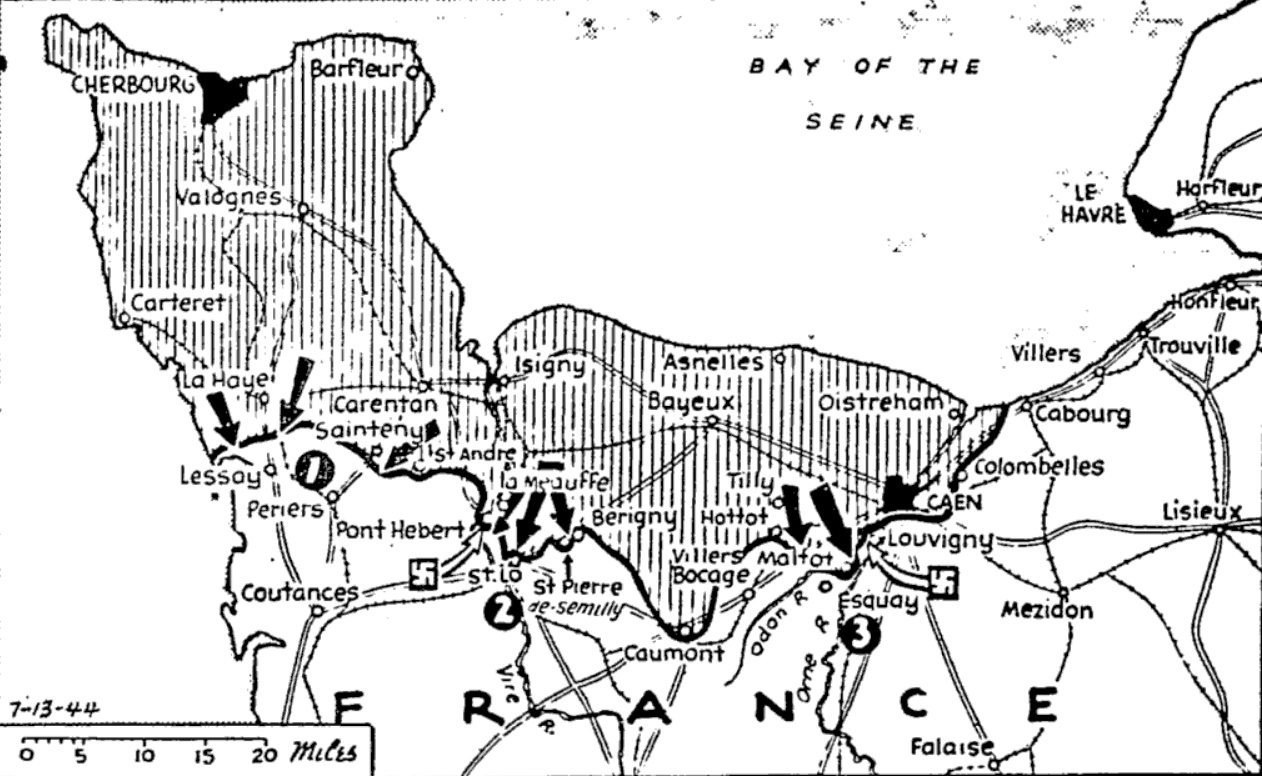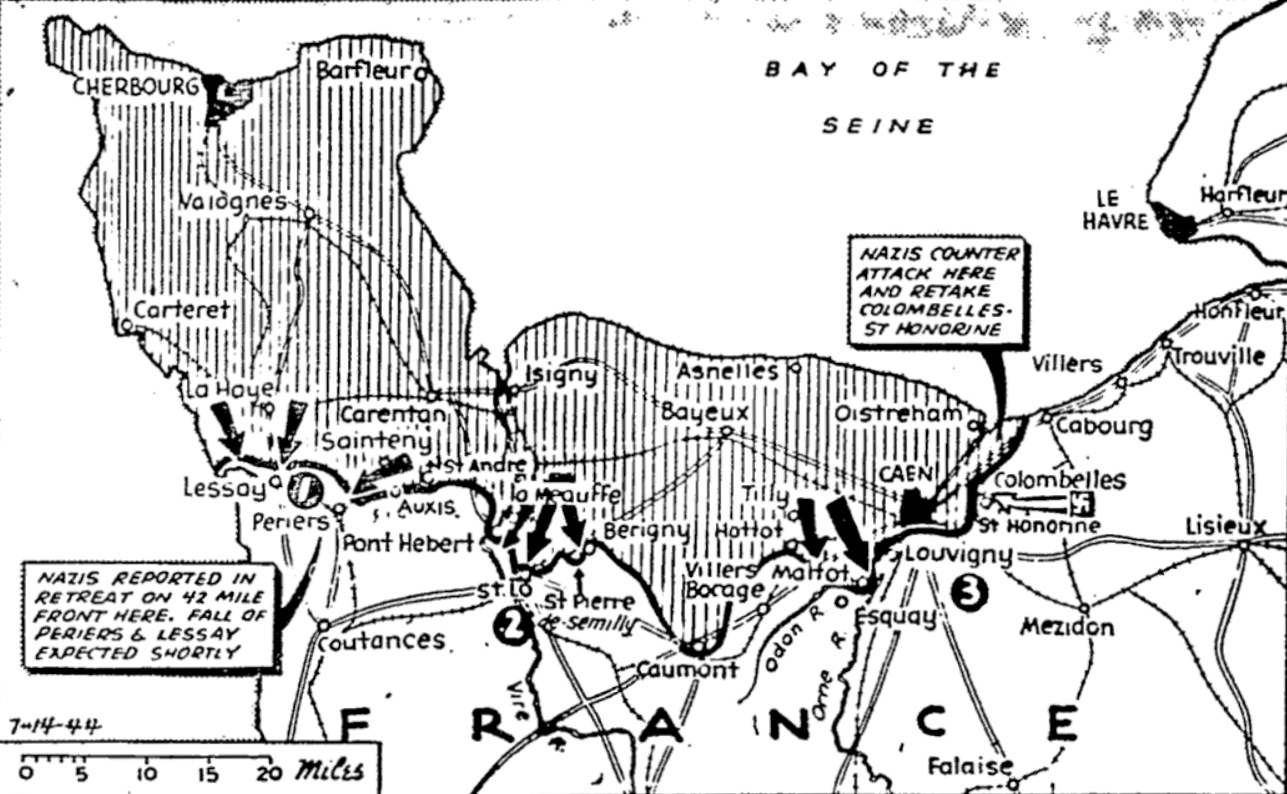Völkischer Beobachter (July 13, 1944)
Die Luftwaffe im ersten Invasionsmonat
Von Kriegsberichter Wilhelm Jung
Zwei Dinge ließen die Invasoren außer Acht, als sie im Vertrauen auf die Ziffernmäßige Stärke ihrer Luftstreitkräfte an der normannischen Küste landeten:
-
Die Härte und Entschlossenheit, mit der sich die deutschen Flieger dem Material und der Masse entgegenwarfen und durch die sie, wie sich am Ende des ersten Invasionsmonats ergibt, selbst unter schweren Bedingungen dem Feind schwere Verluste zufügten.
-
Den Einsatz der neuen Vergeltungswaffe „V1,“ die nicht ohne Rückwirkung auf die Entwicklung der Luftkriegslage gewesen ist.
Greifen wir auf die Erwartungen und Äußerungen repräsentativer amtlicher Persönlichkeiten der Feindseite zurück, die die deutsche Luftwaffe bereits vor Beginn der Invasion als zerschlagen bezeichneten, so können wir am Ende dieses Monats mit Genugtuung feststellen, daß die „niedergekämpfte“ Luftwaffe den feindlichen Luftstreitkräften sogar beachtliche Verluste zufügte. 1.300 Flugzeuge haben die ersten 24 Invasionstage dem Feind gekostet, eine Ziffer, die selbst in Anbetracht der starken anglo-amerikanischen Reserven nicht bedeutungslos ist. Was die Jagdgeschwader in diesen besonders harten Wochen des ersten Aufeinandertreffens der Kräfte an soldatischer Pflichterfüllung geleistet haben, steht auch im Vergleich zu anderen Taten unserer Jagdwaffe in vergangenen Kriegsjahren ohne Vergleich und Beispiel da, weil bisher nirgendwo unter solchen Voraussetzungen gekämpft und dennoch nachhaltige Erfolge heimgebracht wurden. Die Worte „Tapferkeit und Heldenmut,“ die wir in diesem Kriege bei der Würdigung und Dokumentierung der Haltung soldatischer Leistung anwandten, sind, wenn auch mit Recht, zu häufig gebraucht, als daß sie sich steigern ließen. Sie lassen sich nur steigern, indem man zur Schlichtheit zurückkehrt und feststellt, daß diese Männer in schonungslosem Einsatz ihre Soldatenpflicht erfüllen. Wer einige Tage bei unseren Jägern gewesen ist, die vom Büchsenlicht des Morgens bis in die Nacht hinein starten, gegen den Feind fliegen, landen und wieder starten, die durch nichts in ihrer selbstverständlichen Einsatzfreude zu erschüttern sind, versteht das Erstaunen der Feindseite über die Härte, mit der ihm auch im Luftraum begegnet wird.
Wir sprachen mit einem jungen Flugzeugführer, der infolge Motorschadens aussteilen mußte und sich bei der Schirmlandung verletzte. Erst wenige Wochen war er an der Front und hatte bereits acht Abschusse Sein Gesicht macht einen unwilligen und geradezu verbitterten Eindruck, weil er einige Wochen nicht fliegen kann, „während die anderen ihre billigen Abschusse machen.“ Auf unsere erstaunte Frage, daß doch diese Abschüsse alles andere als „billig seien, entgegnete er: „Jetzt sind wenigstens genügend Ziele da. Man verliert keine Zeit mehr mit Warten. Jetzt kommt man immer zu Schuss.“ Dieser junge Flugzeugführer ist mir als der Typ unserer jungen Nachwuchsflieger in Erinnerung geblieben, die heute die Reihen unserer Geschwader ergänzen. Er hat bisher gar nichts anderes kennengelernt als den Kampf gegen einen Feind, der an Zahl immer mehr oder weniger stärker ist, aber er ist seelisch und in seiner fliegerischen Form ganz darauf eingestellt. Nur so sind Einzelleistungen zu erklären wie die einer Staffel, die wir am 15. Invasionstag besuchten und die bis zu diesem Tage bei nur zwei eigenen Verlusten 25 Feindflugzeuge abgeschossen hatte. Bei einem Einsatz schossen fünf Männer dieser Me-109-Staffel aus einem geschlossenen Pulk von 20 Thunderbolt sieben heraus, ohne selbst dabei Verluste zu haben. Eine andere Staffel, die mit acht Maschinen gestartet war, griff 30 bis 40 Mustang an, von denen – wiederum ohne eigene Verluste – acht vernichtet wurden. Zweifellos sind dies einige überdurchschnittliche Einzelleistungen, aber immerhin kennzeichnend für den Geist der Männer, der hier mehr ist als eine „moralische Zutat,“ sondern von greifbarer militärischer Auswirkung ist. Unsere Jäger haben ihre alte Tradition an der neuen Front im Westen würdig fortgeführt.
Die beiden Oberstleutnante Priller und Bühligen, beide Sieger in über hundert Luftkämpfen gegen Engländer und Nordamerikaner, sind in diesen Wochen weit über die Reihen ihrer Waffengattung hinaus zu einem Begriff für den kühnen Widerstandswillen auch im Luftraum geworden. Ein schweres Opfer hat die Jagdwaffe an der Invasionsfront gebracht, als Hauptmann Wurmheller, Träger der Schwerter zum Eichenlaub des Ritterkreuzes, im Luftkampf den Heldentod fand. 102 englische und amerikanische Flugzeuge hat er in die Tiefe geschickt, bis sich sein soldatisches Fliegerleben über Frankreich vollendete.
Während zu Beginn der Invasion Jäger Und Nachtjäger in erster Linie zur Abwehr feindlicher Kampf- und Tiefflieger auf Nachschubstraßen, Eisenbahnknotenpunkte, Fliegerhorste und andere strategisch oder taktisch wichtige Punkte eingesetzt wurden, haben sie nach dem Eingreifen der neuen Vergeltungswaffe „V1“ eine weitere Aufgabe übernommen: die Abwehr der feindlichen Bombenangriffe auf die Stellungen der Vergeltungswaffe.
Noch stärker als in Flugzeugverlusten durch Jagdabwehr hat der Feind die zunehmende Wirksamkeit der deutschen Gegenmaßnahmen zur Luft in den Schlägen empfinden müssen, die deutsche Kampf- und Torpedofliegerverbände der Invasionsflotte zufügten. Die massierte Abwehr zahlloser Geschütze der Schiffs- und Küstenflak hat nicht verhindern können, daß unsere Kampf- und Torpedoflieger in nächtlichen Angriffen Handelsschiffseinheiten aller Art, Fahrgastschiffe von 10.000 bis 20.000 Tonnen, Truppentransporter, Frachter, Kanalfähren, Tanker usw. neben einer Menge von Landungsfahrzeugen aller Art versenkten und etwa die gleiche Anzahl beschädigten.
Luftwaffe, Kriegsmarine, Heeres- und Marineküstenbatterien versenkten im Juni 312.600 Tonnen Handelsschiffsraum, beschädigten über 328.000 Tonnen. Weit über eine halbe Millionen Tonnen Handelsschiffsraum sind also vom Invasionsbeginn bis Ende Juni entweder völlig oder zum anderen Teil für eine gewisse Zeit außer Gefecht gesetzt worden.
Auch die feindliche Kriegsmarine hat, besonders in der dritten Invasionswoche, starke Ausfälle durch Versenkungen und Beschädigungen gehabt. Allein zwei schwere und drei leichte Kreuzer, 22 Zerstörer und 15 Schnellboote wurden versenkt. Von mehreren Schlachtschiffen, 21 Kreuzern und 22 Zerstörern außer einer großen Zahl von Landungsspezialschiffen und Schnellbooten, die nur als beschädigt gemeldet werden konnten, muß angenommen werden, daß ebenfalls ein Teil vernichtet sein wird. Da die feindlichen Kriegsschiffe sich bei Angriffen sehr schnell einnebeln, ist diese Augenbeobachtung sehr erschwert.
Es ist ein Kampf, der große Anforderungen an die fliegerische Kunst und Kaltblütigkeit der Besatzungen stellt, vor allem aber ist er, vom höheren Gesichtspunkt gesehen, ein Kampf, der Zähigkeit und Ausdauer erfordert. Die Auswirkung dieser Versenkungen ist daher nicht plötzlicher Art, sondern braucht ihre Zeit. Eine örtliche und zeitweise Entlastung für die Truppen unseres Heeres bedeutet aber vor allem der Ausfall von Kriegsschiffseinheiten, die als Träger der den Küstenraum beherrschenden Schiffsartillerie der stärkste Rückhalt für die feindliche Front im normannischen Brückenkopf sind. Die Ergebnisse, die im ersten Invasionsmonat von den Kampf- und Jagdverbänden unter Bedingungen von großer Härte erzielt wurden, dokumentieren die ungebrochene Bereitschaft zum rücksichtslosen Einsatz auch im Luftraum gegen den Feind im Westen. Die von Lufttorpedos, Luftminen und Bomben getroffenen Schiffstonnen und 1.300 verlorene Flugzeuge sind Tatsachen, die dem Feind gezeigt haben, daß lediglich in seiner Propaganda die deutsche Luftwaffe „niedergewalzt“ worden ist. Wir sind sachlich genug, diese Leistungen nicht in falschem Optimismus zu überschätzen. Noch stehen wir mitten im Kampf, der auf seine Entscheidung wartet. Dennoch erfüllen uns diese Leistungen voll Stolz, weil sie erstritten wurden in einem Geist, der nicht vor der Masse kapitulierte, sondern seine
Kräfte aus dem unerschütterlichen Pflichtbewusstsein und dem unbedingten Vertrauen in die Gerechtigkeit unserer Sache schöpfte. Wie der Grenadier in den Schützenlöchern der Normandie oder in seinem „Tiger“ sich dem Anprall des hochgerüsteten Feindes entgegenwarf und ihn aufhielt, haben auch die Männer hinter dem Steuerknüppel ihres Flugzeuges, hinter ihren Instrumenten, Funkgeräten und Maschinengewehren alles eingesetzt, den Stoß aufzufangen, der gegen das Herz Europas zielt.

